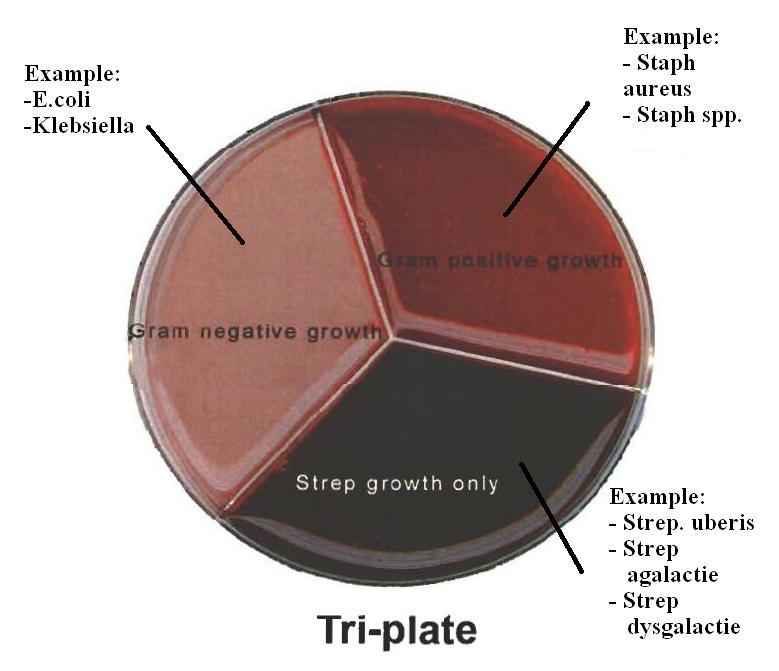We are glad to offer a new milk culture system in our 2 clinics: The TRI-plate system.
What is this new system?

As you can see, from the sample taken from the infected quarter, a small amount is placed on each section of the plate. Depending where the bacteria will grow, we will be able to tell you in 24 HOURS the type of bacteria we are dealing with.
How will this new system change your way to deal with mastitis?
What we suggest is to take a sample of an infected quarter, WITHOUT TREATING THE QUARTER. Bring the sample as soon as possible to one of our 2 clinics. After 24 hours, we will call you back with the results and the treatment plan.
Here is how we will interpret these results:
- If there is a bacterial growth in the « Strep Growth Only » section: We have identified the bacteria and we can start an appropriate treatment.
- If there is a bacterial growth in « Gram Positive Growth – Staph» section: We have identified the bacteria and we can start an appropriate treatment. In this case, we will proceed to a second test (12 hours length) that will tell us if it’s a Staph aureus (contagious mastitis) or not. We will wait for this second test to know if we will establish an aggressive treatment or not. At least, the treatment has already started the day before.
- If there is a bacterial growth in « Gram Negative Growth » section: We have identified the bacteria and we can start an appropriate treatment.
- If there is bacterial growth everywhere on the plate: The sample was contaminated and the result is invalid. You have to take another sample and start the process again.
- If there is NO BACTERIAL GROWTH: This makes a BIG DIFFERENCE! If there is no bacterial growth, it means there are no live bacteria in the milk…. This makes sense! Actually, the cow has already eliminated the infection and she has healed herself; so she DOESN’T NEED ANY ANTIBIOTIC TREATMENT! You only have to milk the cow properly (oxytocin or not), reduce the swelling (Multi-rub, anafen) and wait few days. It should be enough to get rid of those chunks in the milk and let the mammary gland heal on it own. You will save money, won’t discard any milk and won’t have any withdrawal to think about!
FAQ
What happens if I don’t treat my cow for 24 hours and there are bacteria in her quarter? Will she become a chronic mastitis cow?
NO. When you see chunks in the milk, the mastitis started 2-3 days ago but you were just no seeing it! If you wait another 24 hours, it won’t change the cure rate and won’t become a chronic case. In addition, if we identify the bacteria in 24 hours, we will treat her with the appropriate antibiotics instead of treating her with a random drug.
What happens if there is no bacterial growth on your test and my cow still has no improvement after few days?
This test isn’t covering all the bacteria in the world. It’s possible we have something unusual. In those cases, we will recommend taking another sample and we will send it to Guelph for further tests. We want you to know that it won’t change the cure rate or increase the possibility she will become chronic.
What should I do with the milk from a cow with chunky milk in only one quarter?
You can use a milking adapter to milk one quarter separately and the milk from the 3 other quarters go to the bulk tank, or just throw away the milk of this cow. You have to keep in mind that even if you throw this milk away, you will do it only for 1 to 3 days instead of over a week if you would have treated that cow.
How can I use this system on my farm?
The easiest way is to talk to your vet at his next visit to your farm. Basically, we recommend you to take a sample and bring it to us without treating the cow for every case of mastitis you have. It is also possible to use this test for herd screening (subclinical mastitis).
How to take a proper milk sample?
Step 1
Put gloves on to take the milk sample.
Step 2
Make sure the teat is clean and dry before you proceed. Clean the teat end with alcohol.
Step 3
Open the tube sample without touching the inside of it and the cap.
Step 4
Throw the first squirts away and then fill the tube with milk. You have to be sure that you are not holding the sample tube right under the teat. Aim well!
Step 5
Close the tube and apply teat dip.
Step 6
Bring the sample to our clinic. If you bring the sample within 24 hours, just refrigerate. If you bring it more than 24 hours later, freeze it.
